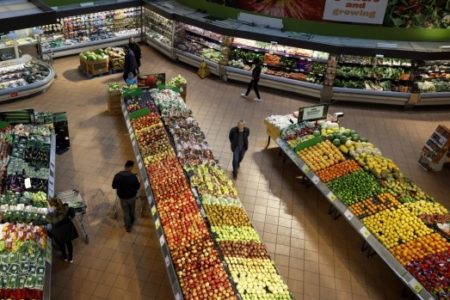December 4, 2019 – In today’s Globe and Mail Report on Business, Ann Hui, national food reporter, writes that food prices in Canada are expected to rise by 4% in 2020, more than double the annual inflation rate. This translates to an increase in a family’s annual grocery bill of $480.
Why is this happening? In her article Hui cites the following:
- Trade issues are increasingly a challenge because of border issues.
- Climate change is impacting domestic and imported supplies of meat, fresh fruit, and vegetables.
- Elimination of single-use plastics is impacting pricing as food suppliers find alternatives.
- The price on carbon is impacting businesses and likely is going to be passed along to consumers.
Let’s drill down a bit on each of these points.
Border Issues and Food Distribution
How bad is trade being disrupted? Canada, Mexico, and the United States have revised the North American Free Trade Agreement but it still has to be passed by the governments of all three countries. In the interim, states Simon Somogyi, Department of Agriculture, Guelph University, in North America, “a truck that took six hours to get through a border three years ago now takes three days.”
Food Supply and Climate Change
Meat consumed in Canada is largely domestically sourced. Why prices are rising has several causes? Feed sources are being affected by extreme weather events from floods to drought causing prices to rise. Rising global demand is making exporting more attractive than the domestic market. And then there is the additional pressure on supply from issues like the global pandemic that has affected pork production with China losing as much as half of its swine population since August 2018.
Sylvain Charlebois, Director of the Agri-Food Analytics Lab at Dalhousie University notes, “every single month there’s at least one product that goes up 10 or 20%,” attributing this to erratic weather patterns, noting the “price of climate change, really is unpredictability.”
Is what is being forecasted in Canada true elsewhere on our planet? In August of this year, the United Nations reported that rising atmospheric temperatures were affecting soil fertility and jeopardizing food supply around the world. More than 1 billion are at food risk while 820 million are classified as malnourished because of changing climate, poor land management, and inappropriate crop selection (biofuel plants versus food).
The changing climate is impacting freshwater supplies and agricultural yields. This is leading to internal displacement within countries of their populations with United Nations estimates of 17.2 million climate migrants in 2019. Future forecasts are even dimmer with the World Bank predicting 143 million being displaced annually by 2050.
And then there is drought which occurs in both the Developed and Developing World. When it happens in the former we describe the losses in dollars. For example, the average loss to U.S. farms over the last 30 years from drought amounts to about $6 billion annually. And since 2001, the 42 highest-ranking agricultural producing countries have experienced $932 billion in losses. These are developed countries and include the U.S., Canada, the European Union, and Australia.
Drought in the Developing World, however, is described not in dollars lost, but in lives. A recent United Nations report estimates that climate change and conflict are causing the undernourishment of Africa’s population impacting as much as 20% of the continent. The latest case is Zimbabwe, which according to the United Nations is affecting half of the country’s population noting a “vicious cycle of skyrocketing malnutrition that hitting women and children hardest.” More than 7 million are affected with poor rains expected before the April harvest which will only make the situation worse. In the capital city, Harare, fresh water is scarce and prices for basic food items have skyrocketed.
Global warming will make drought an even more pervasive threat as the century unfolds. The U.S. National Ocean and Atmospheric Administration (NOAA) monitors drought levels using its land satellites and continues to report the state of vegetated land around the planet. One of the worst drought years was 2012 when 28% was visibly under threat. That number was smaller in 2017 at 17%.
Changes to Packaging by Eliminating Single-Use Plastics
Canada plans to ban single-use plastics by 2021 and introduce new standards for manufacturers of plastic packaging. We are already seeing a move away from styrofoam plates and plastic straws in our throw-away and fast-food world, but changes to packaging will lead to unforeseen costs which likely will be passed on to consumers.
Putting a Price on Carbon
It is early days so far in Canada’s experience with carbon pricing. Today we pay $20.00 per ton of carbon produced which translates to about 4 cents per liter when we purchase gasoline or diesel for our vehicles. In January 2020, that number will rise to $30.00, and again by $10.00 each year in 2021 and 2022. At that point, the added cost will amount to about 11 cents per liter. How will that be reflected in the cost of food distribution? Will the offsetting tax credits families receive make the increase in food costs versus the cash reimbursement a wash? Time will tell.
A Final Note
It is hard to ignore the convergence of atmospheric warming, declining agricultural yields from uncertain weather, and a world population that continues to grow with expectations there will be more than 10 billion of us on the planet by mid-century. It doesn’t take much in the way of prognostication to anticipate food prices rising around the globe. So in 2020 here in Canada, a 4% or $480 rise probably means this country is doing better than most. But I suspect a growing use of food banks for those who find the rising cost of food beyond their means. Not a Happy New Year!









